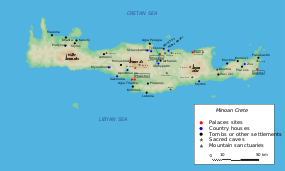 Map of Minoan Crete | |
| Location | Heraklion, Crete, Greece |
|---|---|
| Coordinates | 35°17′38″N 25°29′27″E / 35.29389°N 25.49083°E |
| Type | Minoan town and "palace" |
| History | |
| Cultures | Minoan, Mycenaean |
| Site notes | |
| Excavation dates | 1919-1936, 1964-2012, 2014-present |
| Archaeologists | Joseph Hazzidakis, Fernand Chapouthier, Oliver Pelon, Maud Devolder |
| Public access | Yes |
Malia (also Mallia) is a Minoan and Mycenaean archaeological site located on the northern coast of Crete in the Heraklion area. It is about 35 kilometers east of the ancient site of Knossos and 40 kilometers east of the modern city of Heraklion. The site lies about 3 kilometers east and inland from the modern village of Malia. It was occupied from the middle 3rd millennium BC until about 1250 BC. During the Late Minoan I period (1700 - 1470 BC) it had the third largest Minoan palace, destroyed at the end of the Late Minoan IB period. The other palaces are at Hagia Triada, Knossos, Phaistos, Zakros, and Gournia. It has been excavated for over a century by the French School of Athens and inscriptions of the undeciphered scripts Cretan hieroglyphs, Linear A, and the deciphered script Linear B have been found there.